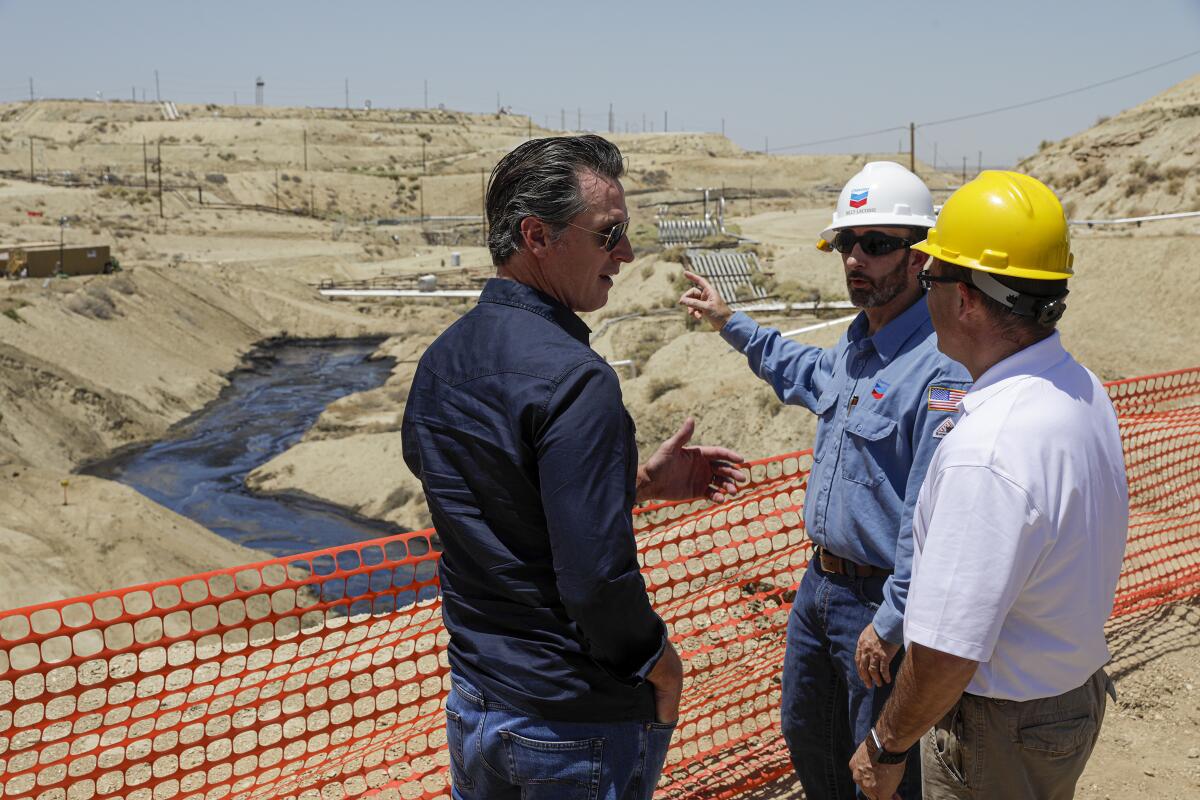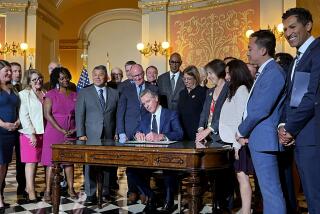Newsom blocks new California fracking pending scientific review

- Share via
SACRAMENTO — In a victory for critics of California’s oil drilling industry, Gov. Gavin Newsom on Tuesday stopped the approval of new hydraulic fracturing in the state until the permits for those projects can be reviewed by an independent panel of scientists.
Newsom also imposed a moratorium on new permits for steam-injected oil drilling, another extraction method opposed by environmentalists that was linked to a massive petroleum spill in Kern County over the summer.
“These are necessary steps to strengthen oversight of oil and gas extraction as we phase out our dependence on fossil fuels and focus on clean energy sources,” Newsom said in a statement Tuesday morning. “This transition cannot happen overnight; it must advance in a deliberate way to protect people, our environment, and our economy.”
Along with halting use of the oil extraction methods, the Newsom administration plans to study the possible adoption of buffer zones around oil wells in or near residential neighborhoods, schools, hospitals and other facilities that could be exposed to hazardous fumes.
The actions come just weeks after Newsom signed a bill into law revising the primary mission of a state agency that regulates the oil industry, now called the Geologic Energy Management Division, to include protecting public health and safety and environmental quality.
Citing similar safety concerns, Newsom also called Monday for the California Public Utilities Commission to expedite planning for the permanent closure of the Aliso Canyon natural gas storage facility in Porter Ranch. Thousands of families in the northwest San Fernando Valley were forced to evacuate starting in 2015 because of a broken well at the facility that led to the largest known release of methane gas in U.S. history. Residents reported suffering from nausea, headaches and nosebleeds, among other ailments.
Catherine Reheis-Boyd, president of the Western States Petroleum Assn., said California already has some of the most strict regulations and environmental protections in the world and that curtailing oil production in the state will have serious consequences.
“It is disappointing that the state would pursue additional studies when multiple state agencies already validate our protection of health, safety and the environment during production,” Reheis-Boyd said in a statement. “These agencies should also consider reliability, affordability and resilience of our energy supply, as every barrel delayed or not produced in this state will only increase imports from more costly foreign sources that do not share our environmental and safety standards.”
State Senate Republican leader Shannon Grove of Bakersfield expressed similar concerns and said Newsom’s actions could be crippling to California’s oil industry.
“The bulk of Kern County’s new oil production will be severely impacted by this policy, as well as future capital investment by the producers,” Grove said in a statement. “If those producers cannot confidently invest in this area, then they will invest elsewhere. The reduction in capital investment will be in the hundreds of millions of dollars in the next twelve months.”
Since taking office, Newsom has faced pressure from politically influential environmental groups to ban new oil and gas drilling and completely phase out fossil fuel extraction in California, one of the nation’s top petroleum-producing states.
But the Democratic governor pushed back, promising to take a more measured approach that addressed the effects on oil workers and California cities and counties that are economically dependent on the petroleum industry.
Some environmental leaders who had questioned Newsom’s commitment were quick to praise the governor on Tuesday.
“This marks the turning of the tide against the oil industry, which has been allowed to drill at will in our state for more than 150 years,” said Kassie Siegel of the Center for Biological Diversity.
Sierra Club California Director Kathryn Phillips said previous governors had the opportunity to act as Newsom did but refused, a not-so-subtle dig at former Gov. Jerry Brown, who rebuffed calls by environmentalists for an outright ban on fracking.
“It pays when you elect someone who is not beholden to the oil industry,” Phillips said. “[Newsom] promised while he was running for office that he wasn’t going to be intimidated by the oil industry, and this sort of shows that’s true. It’s more than any other governor has done in a single day to rein in oil pollution.”
During his 2018 campaign, Newsom vowed to tighten state oversight of hydraulic fracturing, or fracking, and oil extraction in California.
In July, Newsom fired California’s top oil industry regulator after news reports indicated that the new governor’s administration was issuing hydraulic fracturing permits at twice the rate as that under the Brown administration. At the time, Newsom said he did not have the legal authority to impose a state moratorium on fracking.
On Tuesday, Newsom halted all pending fracking permits currently under review by state regulators until they can be scrutinized by independent experts from the Lawrence Livermore National Laboratory.
He also ordered California‘s system for issuing fracking permits to be audited by the state Department of Finance to determine if it complies with state law and asked the agency to recommend ways to strengthen the permitting process.
Newsom also put a stop on Tuesday to the use of a steam-based oil extraction method different from fracking.
Cyclic steam injection pumps super-heated vapor into wells to loosen and liquefy viscous crude oil. Hydraulic fracking involves shooting a high-pressure mix of water, sand and chemicals deep underground to extract oil and natural gas.
Steam injection was suspected to be a factor in one of California’s largest oil spills in decades.
More than 900,000 gallons of oil and brine oozed from a Chevron Corp. facility this summer in McKittrick, a tiny town in oil-rich Kern County. California regulators have fined Chevron $2.7 million for violations at the oil field.
The process also is considered hazardous to oil workers. In 2011, Chevron engineer David Taylor died while he was inspecting a steam-injected well near Taft. The soil caved in beneath him and he fell into a cavity that contained 190-degree water and hydrogen sulfide.
Much like Newsom, Brown was pressured by environmentalists to curtail oil extraction in California. Brown was criticized when he rebuffed them, though he and the Legislature adopted an ambitious goal in 2018 to convert California to a 100%, zero-carbon electrical supply by 2045.
During a 2018 climate summit in San Francisco, the advocacy group Consumer Watchdog ran a local television ad showing a young girl calling the governor “cruel and heartless” for allowing oil rigs near residential areas.
The attacks demonstrated the political perils faced by California politicians who must contend with oil policy. California, which has embraced and pioneered progressive environmental policies, is also home to a billion-dollar oil industry that helps power California’s economy and that has significant political sway in Sacramento. The news organization Maplight reported last year that oil and gas interests have contributed $170 million to California political campaigns since 2001.
Consumer Watchdog President Jamie Court, who earlier this year criticized the Newsom administration’s approval rate for fracking permits during the governor’s first six months in office, said the organization has found that the state has not issued any new fracking permits since mid-July.
“Today’s announcement is a really welcome step in the right direction to create greater scientific scrutiny of questionable well exploration and drill tactics that have been given a rubber stamp under Gov. Brown and the first six months of his administration,” Court said.
A 2016 poll by the nonpartisan Public Policy Institute of California found that most likely voters in the state opposed fracking and increased oil drilling off the coast. A vast majority also favored stricter emission limits on power plants in an effort to address climate change.
Still, California is home to 26 million vehicles with internal-combustion engines, and the oil industry helps support close to 368,000 blue-collar jobs in the state, according to the Western States Petroleum Assn.
There are 72,000 oil-producing wells in the state that last year produced 165.3 million barrels of oil from onshore and offshore facilities, according to the California Department of Conservation. California also consumes more gasoline than any other state — 366 million barrels in 2017, according to the U.S. Energy Information Administration.
More to Read
Sign up for Essential California
The most important California stories and recommendations in your inbox every morning.
You may occasionally receive promotional content from the Los Angeles Times.











